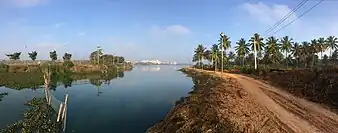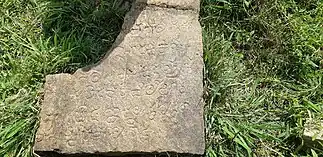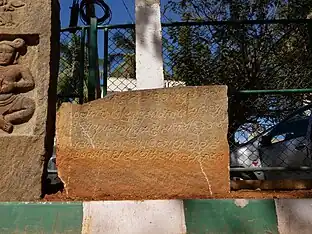
Four inscriptions and hero stones have been found in the suburb of Jakkur, indicating that it is a historic locality of Bengaluru.[1][2]

The four inscriptions are:
- Jakkur 10th Century Prashasti Inscription[3]
- Jakkur 10th Century Kalnadu Inscription[3]
- Jakkur 1342 CE Honnamaranayaka's Donation Inscription[3] (First documented in the Epigraphia Carnatica, Vol 9 as inscription No. 21;[4] a subsequent re-reading of the inscription has been documented in the Bengaluru Ithihasa Vaibhava, December 2021, Jakkur edition[3]
- Jakkur 1432 CE God Allalanatha Pillar Inscription[3]
These inscriptions indicate that Jakkur is at least as old as the 9th or 10th centuries.[5] These inscriptions also indicate that Jakkur Lake, regarded as one of the biggest lakes of Bangalore, existed as many as seven centuries ago.
Two hero stones, one a self-sacrifice[3] memorial stone from the 14th century and another a Maha-Satistone[3] from the 16th-17th centuries are also found at Jakkur.

Jakkur 1432 CE God Allalanatha Inscription
Though this inscription is related to an Allalanatha temple in Jakkur, the 600-year-old temple is not traceable today.[3]

Discovery and Dating
The inscription was discovered in December 2021 by the side of a road by citizen researchers K R Narasimhan and Dhanpal Manchenahalli.[6] Subsequently, the inscription was shifted to nearby ground. The installation date of the inscription is written in the Julian Roman calendar as 10 April 1432 (Indian Calendar: Paridhavi Samvatsara and Chaitra Shukla 10).
Characteristic of stone
The inscription is on a granite stone 62 centimeters long, 33 centimeters wide and 17 centimeters thick. On the right side of the stone is an inscription in nine lines, On the left side there, is an relief of the Vishnu Chakra and on the front there is a sculpture of Anjaneya standing with hands folded in the Anjani mudra. Anjaneya sculptured pillar is related with Vaishnava temple, it can be said that the wheel is the Sudarshan Chakra of Vishnu.
Language and script
The Inscription is in the Kannada language and Kannada script of the fifteenth century.[3]
Transliteration and translation of the inscription in IAST and Modern Kannada
The inscription consists of 9 lines. The transliterated text of the inscription in Kannada and IAST are as follows:

| Transliteration in Modern Kannada | IAST | |
|---|---|---|
| 1 | [ಜ]ಯಾಭ್ಯುದ | [ja]yābhyuda |
| 2 | [ಯ ವ] ರುಷ ೧೩೫ | [ya va] ruṣa 135 |
| 3 | (೪) [ಪ] ರಿದಾವಿ ಸಂ | (4) [pa] ridāvi saṃ |
| 4 | [ಚ] ಯಿತ್ರ ಸು ೧೦ | [ca] yitra su 10 |
| 5 | ಅಲ್ಲಾಳನಾತ | allāl̤anāta |
| 6 | . ಕ . ಸಮುದ್ರ | . ka . samudra |
| 7 | ೦ಮಿಸಿತ್ತ | ṃmisitta |
| 8 | . . ಸೇವೆ | . . sevĕ |
| 9 | . . . ಕಂಬ | . . . kaṃba |
Summary of the inscription
This inscription is a record of the donation of a Garuda pillar to an Allalanatha temple in 1432 CE. As the letters of the inscription are worn out, the full inscription is not readable.
Jakkur 1000 CE Kalnadu inscription

Jakkur is famous for some inscriptions in which this 1000 CE Kalnadu inscription is included.
From this inscription it can be known that Jakkur has a history of thousand years. As the stone is broken the full inscription is not available for reading the broken inscription seems to indicate Sanjayappa of this village sacrificed his life and his family was made some donation. Such grants were given so that the families of heroes who have fought for society or died to protect their village were financially supported. Such grants were called Kalnatu/Kalnadu.[3]: 46–49
Discovery and Dating
This inscription was discovered by researchers K. R. Narasimhan[7]: 409 and P. L. Udaya Kumar (23-Dec-2017).
This inscription belongs to about 10th century and is in Kannada language and kannada script.[3]
Characteristics of the inscription stone
The stone on which this inscription is engraved is of granite, 75 cm height and 75 cm width, 15 cm thickness. The upper left corner of the stone is broken and only six lines of writing can be recognized.

Transliteration of the inscription in modern Kannada
The inscription is of 6 lines and the transliterated text of the inscription in Kannada and IAST are as follows:
| Transliteration in Modern Kannada | IAST | |
|---|---|---|
| 1 | . . . . . ಮ್ಮಕಲಿಗ ಸ | . . . . . mmakaliga sa |
| 2 | . . . . . ಣ್ನನಾಡ ಜಕ್ಕಿಯೂ | . . . . . ṇnanāḍa jakkiyū |
| 3 | . . .. . .. ಸಲಗುವ ಸಂಜಪಯ್ಯನುಂ | . . .. . .. salaguva saṃjapayyanuṃ |
| 4 | . . . . . ಮೞಿದವಂ ಕವಿಲೆ ಬಾರ | . . . . . maḻidavaṃ kavilĕ bāra |
| 5 | . . . . .ೞಿದ೦ ಇ ಕಲ್ನಾಡು ಗುದುರಾ | . . . . .ḻida0 i kalnāḍu gudurā |
| 6 | . . . .. . . . ನೆನ್ದಕಮಾಲೆಗೊಟ್ಟ | . . . .. . . . nĕndakamālĕgŏṭṭa |

Summary of the inscription
Kalnadu was given to Sanjapayya of Sunnadu (small country) Jakkur, He who destroyed it the inscription records the curse that Kavile was killed in Varanasi. As the statute is vague, it is not possible to know the full gist.
Jakkur 10th Century Prashasti Inscription

The Jakkur Prashasti Inscription is an ancient and significant epigraphic record found in the village of Jakkur.

Discovery of the Inscription
This inscription was discovered by KR Narasimhan[7] and Dhanapal Manchenahalli. Then the stone was found buried in the soil. Later with the cooperation of locals Srikanthappa, Ravigowda, Nagarajappa, Srinivas to nearby KV Bhairegowda Kalamandir.(13°04'44.1'N 77°36'26.1°E)
Period of the Inscription
There is no reference to time of this Inscription, however, on paleographic grounds the inscription has been dated to the 10th century.
Transliteration of the Inscription in Modern Kannada and IAST
The inscription is of 5 lines, and the transliterated text of the inscription in Kannada and IAST is as follows:[3]: 42–45
| IAST | Modern Kannada | |
|---|---|---|
| 1 | . . ma . da gāl̤gaṃgavāḍi tŏṃbhattaṟusāyi | ಮ ದ ಗಾಳಂಗವಾಡಿ ತೊಂಭತ್ತುಸಾಯಿ |
| 2 | ramaneka chatracchāyĕyŏl̤arasugĕyyu | ರಮನೇಕ ಛತ್ರಚ್ಛಾಯೆಯೊಳರಸುಗೆಯ್ಯು |
| 3 | ttirĕ svasti samasta prasasti sahita śrīmat | ತಿರೆ ಸ್ವಸ್ತಿ ಸಮಸ್ತ ಪ್ರಸಸ್ತಿ ಸಹಿತ ಶ್ರೀ ಮತ್ |
| 4 | navalakkadahal̤ādhipatiyappa ballava | ನವಲಕ್ಕದಹಳಾಧಿಪತಿಯಪ್ಪ ಬಲ್ಲವ |
| 5 | tirāyaṃ gŏbĕṭṭada birudasĕdevana kāl̤ĕga | ತಿರಾಯಂ ಗೊಬೆಟ್ಟದ ಬಿರುದಸೆದೇವನ ಕಾಳೆಗ |
Characteristics of the Inscription
This inscription is engraved on a granite stone, The stone is 72 cm tall, 108 cm wide and 15 cm thick. The front side of the stone has been dressed and prepared for inscribing while the back side is not prepared in any way. The irregular edges of the stone indicate the stone has been broken.
The inscription is in 10th century Kannada script and language.
Summary of the Inscription
The inscription mentions a conflict between Ballavathirayanna, the ruler of Navalakka, and Birudasedeva of Gobetta. And at that time Jakkuru village belonged to Gangavadi ninety six thousand country.
See also
References
- ↑ "A hunt for Bengaluru's forgotten inscription stones is tracing the history of Kannada and the city". 30 April 2018.
- ↑ "Hoysala Era Inscription Found in Jakkur".
- 1 2 3 4 5 6 7 8 9 10 11 12 ಬೆಂಗಳೂರು ಇತಿಹಾಸ ವೈಭವ ಡಿಸೆಂಬರ್ 2021 ಸಂಚಿಕೆ 2 ಜಕ್ಕೂರು [Jakkur 10th Century Kalnadu Inscription] (in Kannada). Bengaluru, India: The Mythic Society. December 2021. ISBN 978-81-954980-8-6.
- ↑ Rice, Benjamin Lewis. Epigraphia Carnatica vol9 mysore. Bangalore Mysore Govt. Central Press.
- ↑ "Tracing Local History through Inscriptions".
- ↑ "BMTC driver's curiosity leads to discovery of hidden temple built in 1539 AD in Bengaluru". International Business Times. 13 January 2018.
- 1 2 Narasimhan, K. R. (2018). "Bengalurina haagu Nagavarada Aprakatitha Shasanagalu" [Unpublished Self-Sacrifice Sculptures and Other New Finds] (in Kannada). ಕರ್ನಾಟಕ ಇತಿಹಾಸ ಅಕಾದೆಮಿ.